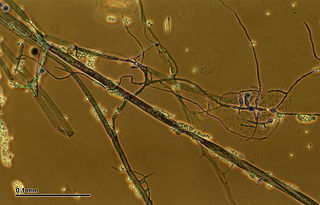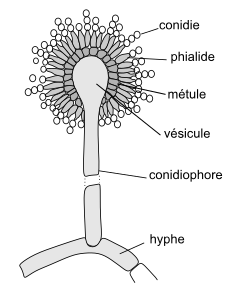
Penicillium is a genus of ascomycetous fungi that is part of the mycobiome of many species and is of major importance in the natural environment, in food spoilage, and in food and drug production.

The Eurotiales are an order of sac fungi, also known as the green and blue molds. It was circumscribed in 1980.

The Trichocomaceae are a family of fungi in the order Eurotiales. Taxa are saprobes with aggressive colonization strategies, adaptable to extreme environmental conditions. Family members are cosmopolitan in distribution, ubiquitous in soil, and common associates of decaying plant and food material.

Aspergillus is a genus consisting of several hundred mold species found in various climates worldwide.
The Westerdijk Institute, or Westerdijk Fungal Biodiversity Institute, is part of the Royal Netherlands Academy of Arts and Sciences. The institute was renamed on 10 February 2017, after Johanna Westerdijk, the first female professor in the Netherlands and director of the institute from 1907 to 1958. The former name of the institute was CBS-KNAW Fungal Biodiversity Centre or Centraalbureau voor Schimmelcultures. Despite the name change the collection maintained by the institute remains the CBS collections and the use of CBS numbers for the strains continues.

Paecilomyces is a genus of fungi. A number of species in this genus are plant pathogens.

The fungi imperfecti or imperfect fungi are fungi which do not fit into the commonly established taxonomic classifications of fungi that are based on biological species concepts or morphological characteristics of sexual structures because their sexual form of reproduction has never been observed. They are known as imperfect fungi because only their asexual and vegetative phases are known. They have asexual form of reproduction, meaning that these fungi produce their spores asexually, in the process called sporogenesis.
Chester Ray Benjamin was an American mycologist. His research was focused on the taxonomy of fungal molds belonging to the orders Eurotiales and Mucorales. Born and raised in Ohio, Benjamin received his undergraduate education from Mount Union College in Alliance after serving in the Navy for four years during World War II. Benjamin earned his Doctoral degree in 1955 from the University of Iowa under the tutelage of George Willard Martin.
Penicillium ehrlichii is a species of fungus in the genus Penicillium in the order of Eurotiales. In Penicillium, it is placed in the series Janthinella in the section Lanata-Divaricata.
Penicillium imranianum is a species of fungus in the genus Penicillium.
Thermoascus is a genus of soil fungi in the family Trichocomaceae. Species in the genus are characterized by the production of heat-resistant ascospores. Thermoascus was circumscribed by German botanist Hugo Miehe in 1907.
Dr. Martha Christensen was an American mycologist, botanist and educator known as an expert in fungal taxonomy and ecology, particularly for soil-dwelling fungi in the genera Aspergillus and Penicillium.
Monascaceae is a former family of fungi in the subclass Eurotiomycetidae.
Gintaras Kantvilas is an Australian lichenologist, who earned his Ph.D in 1985 from the University of Tasmania with a thesis entitled Studies on Tasmanian rainforest lichens. He has authored over 432 species names, and 167 genera in the field of mycology.

Thamnidium is a genus of fungi belonging to the family Mucoraceae.
Eurotium is a genus of fungi belonging to the family Aspergillaceae.
Thermoascaceae is a family of molds in the order of Eurotiales.
Thermoascus aegyptiacus is a species of fungus in the genus Thermoascus in the order of Eurotiales.
Paecilomyces formosus is a species of fungus in the genus Paecilomyces in the order of Eurotiales.
Paecilomyces paravariotii is a species of fungus in the genus Paecilomyces in the order of Eurotiales, closely related to Paecilomyces variotii.








